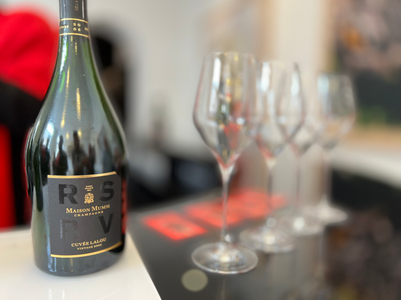G. H. Mumm Champagne
- Wayne Schmidt

- Jun 26, 2022
- 3 min read
Updated: Dec 16, 2023
Let's talk about Champagne. We finally made it to the champagne region in France, a destination on our bucket list.
With only a few days, we needed to select the champagne houses we would visit for tours and tastings, and Mumm has always been a favourite and consistent champagne of the Schmidts, so it was on the list.
G. H. Mumm, situated in Reims in northern France, ranks in the top three champagne producers. Mumm is pronounced as 'Moom'.
Mumm is also the first to launch a bottle of gravity-defying Champagne, enabling it to be consumed in outer space.
Mumm became part of the Pernod Ricard Group in 2005, which owns an extensive portfolio of spirit producers, wineries, and Perrier-Jouët.
Mumm cellars in Reims were founded by three brothers, Jacobus, Gottlieb and Phillip Mumm, German winemakers from the Rhine valley, and G. Heuser and Friedrich Giesler, in 1827.
The tour is one of the more technical, which dives deeper into the production of Champagne. We learned a lot about our favourite beverage whilst being escorted through the 25kms of cellars beneath the champagne house.
The harvest - The grapes are picked by hand between August and October; after picking the grapes, they are pressed carefully to keep the juice clear and white.
The First fermentation - The juice is put into an open tank (allowing the carbon dioxide to escape), and the first fermentation occurs. The result is an acidic still wine that has been fermented dry entirely.
The Assemblage - White wines are combined with some reserve wines to create the base wine for Champagne; Pinot Noir, Pinot Blanc and Chardonnay are blended. The assemblage starts in the early spring, about five months after the harvest.
The Second fermentation - A mixture of yeast, yeast nutrients and sugar (liqueur de tirage) is added to the wine in the second yeasting; the wine is put in a thick glass bottle and sealed with a bottle cap. The wine bottles are placed in a cool cellar to ferment slowly and produce alcohol and carbon dioxide. This is the most crucial part; the carbon dioxide cannot escape from the bottle and dissolves into the bottle.
The Aging - As the fermentation proceeds, yeast cells die, and the fermentation process is complete after several months. However, the Champagne continues to age in the cool cellar for several more years resulting in a toasty, yeasty character. The best and most expensive Champagne is aged for five years or more.
The Riddling - The Champagne bottle is placed upside down in a holder at a 75-degree angle. Each day, the riddler gives the bottle a 1/8th of a turn whilst keeping it upside down. This procedure forces the dead yeast cells to float into the bottleneck, subsequently removing them. The bottles are placed in racks, with the bottlenecks facing downwards.
The Disgorging - The Champagne bottle is kept upside down while the neck is frozen in an ice-salt bath. This procedure results in forming a plug of frozen wine containing the dead yeast cells. Finally, the bottle cap is removed, and the pressure of the bottle's carbon dioxide gas forces the frozen wine plug out ("disgorging"), leaving behind clear Champagne. By doing so, a little bit of wine gets spilled out of the bottle.
The Dosage - A mixture of white wine, brandy and sugar (Liqueur de tirage/Liqueur d'expédition) is added to adjust the wine's sweetness level and top up the bottle. This procedure decides whether the Champagne will be Brut Nature, Extra Brut, Brut, Extra Dry, Dry, Semi-Dry or Doux.
The Corking - The bottle is corked, and the cork is wired down to secure the high internal pressure of the carbon dioxide in the Champagne.
Once you are fully educated on the champagne-making process, you are treated to a tasting based on your preference. We opted for the Grand Cru tastings and were treated to the members-only champagnes that are only available to purchase from the champagne house in Reims. The tour was €45 each, including the tasting.
Fun fact - it takes approximately four years to produce one bottle of non-vintage Champagne,













































Comments